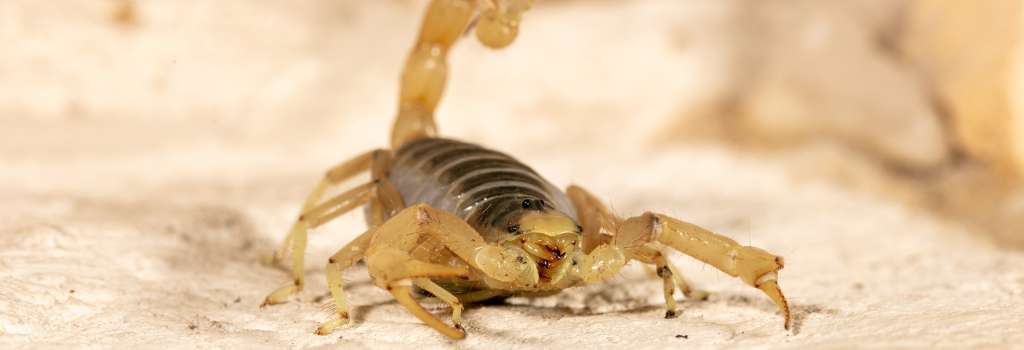Scorpions are a common nuisance for us in Southern California, and you’ve probably seen one yourself or at least know someone who has. These little pests typically blend into the natural landscape, going largely forgotten about until we see one in our backyards or skittering across the sidewalk at night. However, in addition to being an unwelcome surprise for many of us, they can be a real danger to our pets thanks to their venom and stingers.
Cats and dogs love sniffing around and exploring outside, but during these outings, there is always a chance that a scorpion is lurking around nearby. While most scorpions around here aren’t deadly, their stings can be painful and send your dog or cat on a stressful and unplanned trip to the vet. Knowing where scorpions like to hide, how to spot the signs of a sting, and what to do if your dog or cat gets stung can help you keep your pet safe and be ready to act if a mishap with a scorpion does occur.
Are Scorpions Dangerous to Pets?
Yes, scorpions are generally considered dangerous to pets, but the amount of danger they present is highly dependent on the species of scorpion. While most scorpion species in the United States will cause non-life-threatening injuries to dogs and cats, there are a few that can cause severe symptoms and even death when prompt care isn’t given to the affected pet.
While most of the common scorpion species will deliver stings that are similar to a bee sting, causing localized pain, swelling, and redness at the sting site, there are others that will inject more dangerous venom into a pet through their sting. In some species, the venom contains neurotoxins that can interfere with nerve function and other bodily systems.
The most dangerous species of scorpions found in the United States include:
- Arizona Bark Scorpion: This species is the most dangerous scorpion in North America. Its venom can cause severe neurological signs like tremors, muscle twitching, and difficulty breathing in pets. The Arizona Bark scorpion is most commonly found in Arizona, but can also be seen in parts of Nevada, New Mexico, and southeastern California.
- Striped Bark Scorpion: Common across Texas, Oklahoma, Arkansas, and nearby states, the Striped Bark Scorpion can deliver painful stings to cats, dogs, and people, but these are typically non-life-threatening with proper care.
- Giant Hairy Scorpion: This species is the largest scorpion in North America, and can be found in Arizona, Nevada, and the desert regions of California. Similar to the sting of the Striped Bark Scorpion, stings are considered very painful, but those affected by them generally heal well with no complications.

Scorpion Stings vs. Bites
When it comes to how scorpions actually affect our pets, there’s an important distinction to be made between scorpion “bites” and “stings,” as some owners may use these terms interchangeably when searching online or speaking with their pet’s veterinary care team.
Scorpions do not bite; they only sting, and this is the real danger that they present to our pets.
If your dog or cat has been noticeably injured by a scorpion, they were likely stung and envenomated. Scorpions are easily recognizable due to their unique body shape and long, curling tails, and these tails are instrumental in their ability to sting. Scorpions utilize their stingers for both hunting and protection. When a cat or dog – or even a human – gets stung by a scorpion, it’s typically because the scorpion was disturbed and treated the larger animal as a threat.
Scorpions deliver their sting with a sharp, curved tip at the end of their tail, called the aculeus. Inside this tail segment, there are venom glands that inject venom when the scorpion jabs downward into prey or a perceived threat. As we discussed, all scorpions have venom, but the degree to which the venom will affect a human or animal will differ based on the species. While all scorpion stings should be evaluated by a veterinarian, pet owners should be aware that scorpions have the ability to control the amount of venom they release in a sting – sometimes delivering a mild “warning” sting – making isolated incidents less painful and bothersome to pets in some cases.
Where Dogs and Cats Can Encounter Scorpions
Scorpions can be found across the United States, but are more common in warm, dry regions where desert and rocky landscapes are abundant, like the Southwest. Due to Encinitas’ proximity to the coast, it’s not a prime scorpion habitat, like some other desert-like areas of California, such as Palm Springs. However, this doesn’t mean that our area is scorpion-free. California Common Scorpions are found throughout San Diego County and other areas of Southern California and can sting us and our pets. Thankfully, these scorpions are not considered too dangerous, and their stings are comparable to those of a bee.
More dangerous scorpions can sometimes make their way into the area when accidentally transported, but they won’t thrive in the environment, so encounters with them are few and far between.
Scorpions are nocturnal, so they like to find cool, dark spaces to hide in during the day, and then emerge at night to hunt and move around. Because of these habits, dogs and cats are most likely to encounter scorpions in and around the home at night or when exploring hiding places during the day.

Inside of wood piles, under rocks or other garden debris, inside garages or sheds, and in some cases, even inside outdoor furniture, shoes, or pet bedding left outside, are all places scorpions can hide during the day and be found by curious cats and dogs. Our pets can also encounter scorpions out on walks or hikes if they’re prone to sniffing around and exploring, so be sure to keep an eye on your pet during these outings, especially if you’re in areas with dense vegetation or rocky terrain where scorpions could easily hide.
Common Symptoms of Scorpion Stings in Dogs and Cats
If your cat or dog was stung by a scorpion, they may exhibit some of the following symptoms:
- Sudden yelp, pawing at the face or body, or excessive grooming of the sting site
- Local pain, swelling, or redness
- Lethargy or restlessness
- Tremors, muscle twitching, or unsteady walking
- Drooling or pawing at the mouth if stung on or near the face
- Dilated pupils or eye sensitivity to light (with more venomous species)
Call your veterinarian or the nearest emergency clinic right away for guidance, even if your pet only shows mild symptoms. Because pets may react differently depending on their size, age, and overall health, it’s always safest to have a professional evaluate the situation.
What Does a Scorpion Sting Look Like on a Dog or Cat?
Due to their visual similarities to insect bites and bee stings, scorpion stings can sometimes be tricky for pet owners to spot. Additionally, because the sting is delivered by a single stinger, the sting site can be difficult to spot when compared to something larger, like a snake bite.
If you suspect your pet has been stung by a scorpion, be on the lookout for:
- A small red bump or raised welt
- Mild to moderate localized swelling
- Sometimes, there is no obvious mark, but the pet reacts strongly to pain
- In more serious cases, the site may feel firm or warm to the touch
Because scorpion stings in dogs and cats can be difficult to see, it’s incredibly important to pay close attention to your pet’s behavior to discern if there are any noticeable differences that align with symptoms of a scorpion sting. If your dog or cat suddenly cries out or yelps while out in the yard, starts limping out of nowhere, or has a new spot on their limbs, body, or face that they just can’t seem to leave alone or stop grooming, it’s time to take them to the vet to be evaluated.
Can Scorpions Kill Dogs and Cats?
In some situations, scorpion stings can be fatal to pets, but it largely depends on the type of scorpion and the size, age, and overall health of the pet that was stung. Again, usually only the most dangerous types of scorpions with toxic venom will have a severe impact on a pet’s health, but with prompt veterinary intervention, even stings from these scorpions are not always fatal.
If a cat or a dog were stung multiple times by a scorpion, their reaction may be more severe, and they may experience more pain or swelling than is typical.
What to Do If Your Cat or Dog Is Stung by a Scorpion
Even though not all scorpion stings are considered medically significant, they should still be taken seriously, and pet owners in areas with scorpion populations should have a plan of action ready in case their pet has an encounter with a scorpion. The first thing you need to do if your cat or dog is stung by a scorpion is to remain calm. Panicking and getting your pet riled up isn’t going to do any good, and in many cases, it makes transporting your pet to the veterinarian safely more difficult. Bring your pet inside immediately after a scorpion encounter, too, to prevent any additional stings.
Once you and your pet are safe, call your veterinarian or local emergency vet. Let them know your pet’s symptoms, current condition, and any additional details about how or where your pet was stung. If you saw the scorpion, share any details about its size and appearance with the veterinary team, too, to help them better understand what type of scorpion sting they are dealing with.
On your way to the vet, you’ll want to keep your pet as still as possible to help prevent the venom from circulating through their body. If you have a friend or family member available, it can be a good idea to have them hold the pet for the duration of the car ride to keep them still and provide some comfort to calm them down. If your pet seems to be in a lot of pain, you can try applying a cool compress to the sting site to reduce swelling while you wait for the vet, but only do so if it’s safe to do so and not while you’re driving.
If you have questions and you'd like to reach out to us, you can call us directly at (760) 456-9556, or you can email us at [email protected]. Don't forget to follow us on social media Facebook, Instagram.

